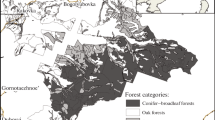Abstract
Participation of the entomofauna in the succession of forest biogeocenoses is analyzed. In stable ecosystems, insects serve as a mechanism providing for long-term ecological stability. In unstable ecosystems, their activities are essentially negative and cause ecosystem degradation.
Similar content being viewed by others
REFERENCES
Baranchikov, Yu.N. and Kharitonchenko, R.P., Daily Dynamics of Insect Excrement Input into the Litter in the Focus of Siberian Moth Population Outbreak, in Rol’ podstilki v lesnykh biogeotsenozakh (Role of Litter in Forest Biogeocenoses), Moscow: Nauka, 1983, pp. 18–19.
Boldaruev, V.O., Dinamika chislennosti sibirskogo shelkopryada i ego parazitov (Population Dynamics of Siberian Moth and Its Parasites), Ulan-Ude: Buryat. Knizhn. Izd., 1969.
Falaleev, E.N., Pikhtovye lesa Sibiri i ikh kompleksnoe ispol’zovanie (Fir Forests of Siberia and Their Comprehensive Exploitation), Moscow: Lesnaya Promyshlennost’, 1964.
Furyaev, V.V., Rol’ pozharov v protsesse lesoobrazovaniya (Role of Fires in the Forest-Forming Process), Novosibirsk: Nauka, 1996.
Isaev, A.S. and Girs, G.I., Vzaimodeistvie dereva i nasekomykh-ksilofagov (na primere listvennitsy sibirskoi) (Interactions of a Tree and Xylophagous Insects: An Example of Siberian Larch), Novosibirsk: Nauka, 1975.
Isaev, A.S., Rozhkov, A.S., and Kiselev, V.V., Chernyi pikhtovyi usach (Monochamus urussovi (Fissh.) (Sawyer Beetle Monochamus urussovi (Fissh.)), Novosibirsk: Nauka, 1988.
Kolomiets, N.G., Siberian Moth and its Role in Coniferous Forests of Western Siberia, in Estestvennoe vozobnovlenie khvoinykh v Zapadnoi Sibiri (Natural Regeneration of Coniferous Species in Western Siberia), Novosibirsk: RIO Sib. Otd. Akad. Nauk SSSR, 1962a, pp. 137–161.
Kolomiets, N.G., Parazity i khishchniki sibirskogo shelkopryada (Parasites and Predators of Siberian Moth), Novosibirsk: Sib. Otd. Akad. Nauk SSSR, 1962b.
Kondakov, Yu.P., Phytocenotic Features of Population Outbreaks of Needle-and Leaf-Gnawing Insects in Siberian Forests, in Ekologicheskaya otsenka mestoobitanii lesnykh zhivotnykh (Ecological Evaluation of Forest Animal Habitats), Novosibirsk: Nauka, 1987, pp. 29–40.
MacLean, D.A., Effects of Spruce Leaf Roller Population Outbreaks on Productivity and Stability of Balsam Fir Forests, Lesovedenie, 1984, no. 2, pp. 61–68.
McDonald, D.R., Biological Interactions Associated with Spruce Budworm Infestations, in Ecological Effects of Nuclear War. Brookhaven Nat. Lab. Publ., 1965, no. 917, pp. 61–68.
Polikarpov, N.P., Chebakova, N.M., and Nazimova, D.I., Klimat i gornye lesa Yuzhnoi Sibiri (Climate and Mountain Forests of Southern Siberia), Novosibirsk: Nauka, 1986.
Prozorov, S.S., Korshunova, L.M., and Zemkova, R.I., Antique Tussock Moth (Orguia antique L.), a Pest of Siberian Larch, in Zashchita lesov Sibiri ot nasekomykh-vreditelei (Protection of Siberian Forests from Pest Insects), Moscow: Akad. Nauk SSSR, 1963, pp. 5–29.
Smagin, V.N., Il’inskaya, S.A., Nazimova, D.I., Novosel’tseva, I.F., and Cherednikova, Yu.S., Tipy lesov gor Yuzhnoi Sibiri (Forest Types in the Mountains of Southern Siberia), Novosibirsk: Nauka, 1980.
Yanovskii, V.M., Comparative Analysis of the Fauna of Dendrophagous Insects in the Forests of Northern Khakassia, in Zakonomernosti rasprostraneniya i dinamika chislennosti lesnykh nasekomykh (Trends in the Distribution and Population Dynamics of Forest Insects), Krasnoyarsk: Inst. Lesa i Drevesiny, 1978, pp. 20–40.
Yanovskii, V.M., Ecological-Faunistic Evaluation of Dendrophilous Insects of Mongolian People’s Republic, in Fauna lesov basseina ozera Baikal (Forest Fauna of the Lake Baikal Basin), Novosibirsk: Nauka, 1979, pp. 78–92.
Yanovskii, V.M., Major Forest Pests in Mongolian People’s Republic, in Lesa Mongol’skoi Narodnoi Respubliki (khozyaistvennoe ispol’zovanie) (Forests of Mongolian People’s Republic: Commercial Use), Moscow: Nauka, 1980, pp. 116–137.
Yanovskii, V.M., Effects of Entomophages on Population Dynamics of Bark Beetles, in Chteniya pamyati N.A. Kholodkovskogo (N.N. Kholodkovskii Memorial Lectures), Leningrad: Nauka, 1982, pp. 25–53.
Yanovskii, V.M. and Baranchikov, Yu.N., Polyphagy of Monochamus urussovi (Coleoptera, Cerambycidae), Zool. Zh., 1999, vol. 78, no.7, pp. 889–890.
Yanovskii, V.M., Baranchikov, Yu.N., Perevoznikova, V.D., Novikov, A.P., and Khodykina, V.N., Entomofauna of Larch Forests Defoliated by Siberian Moth, in Entomologicheskie issledovaniya v Sibiri. Vyp. 1 (Entomological Investigations in Siberia, Issue 1), Krasnoyarsk: Izd. KF SO REO, 1998, pp. 33–43.
Yanovskii, V.M., Baranchikov, Yu.N., Perevoznikova, V.D., and Novikov, A.P., The Response of Entomofauna to Defoliation of Fir Forests by Siberian Moth, Lesovedenie, 2001, no. 5, pp. 44–49.
Yanovskii, V.M. and Girs, G.I., Ground Fires as a Cause of Population Outbreaks in Needle-Gnawing Insects, Lesn. Zh., 1999, no. 6, pp. 13–17.
Yanovskii, V.M. and Vetrova, V.P., Groups of Xylophagous Insects in the Loci of Mass Reproduction of Sawyer Beetle, in Fauna i ekologiya chlenistonogikh Sibiri (Fauna and Ecology of Siberian Arthropods), Novosibirsk: Nauka, 1981, pp. 205–207.
Author information
Authors and Affiliations
Additional information
__________
Translated from Ekologiya, No. 3, 2005, pp. 227–230.
Original Russian Text Copyright © 2005 by Yanovskii.
Rights and permissions
About this article
Cite this article
Yanovskii, V.M. Role of the Forest Entomofauna in Successional Processes. Russ J Ecol 36, 205–208 (2005). https://doi.org/10.1007/s11184-005-0060-8
Received:
Issue Date:
DOI: https://doi.org/10.1007/s11184-005-0060-8




